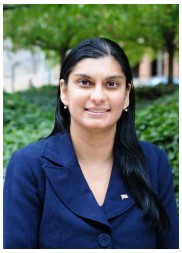Good evening - There was an error in the presentation title in the previous newsletter. Please see correction below, we look forward to seeing you on Tuesday May 4th for Dr. Wanjara's presentation!
|
ASMI Puget Sound April
Meeting (05/04/21):
Online Presentation
ASMI TRUSTEE’S NIGHT
Location: Zoom / RingCentral
Date: Tuesday, May 4th
Time: Social Gathering 5:15 pm PST
Presentation 5:30 pm PST
Cost: Free
RSVP: Please email your RSVP by Sunday, April 11 to psasmnewsletter@gmail.com
The Zoom link will be to be sent to you upon receipt of the RSVP.
Speaker:
Dr. Priti Wanjara, FASM
ASMI Trustee (2019-2022)
|
Calendar:
· Summer 2021!
Committee:
· Open Position [Chair]
· Luis Leon [Vice Chair]
· Keith Anderson [Secretary]
· Mary Davis [Treasurer]
Announcements:
ASMI Puget Sound Seeking Chair for 2020 – 2021 and Officers and Board Members for 2021 – 2022.
There is an opportunity for young, emerging professionals, or mid-career materials engineers to step in and fill positions in the Puget Sound Chapter. If you are interested send an email to psasmnewsletter@gmail.com.
|
|
Title: Wire-Fed Electron Beam Additive Manufacturing of Ti6Al4V
|
|
 |
Dr. Priti Wanjara, FASM
Principal Researcher and Manager
National Research Council of Canada
Aerospace
Montreal, Quebec, CANADA
|
|
|
BIO: Dr. Priti Wanjara is Principal Researcher and Manager at the National Research Council of Canada. She earned her B. Eng (1993) and Ph.D. (1999) degrees from McGill University in Metallurgical and Materials Engineering. She started working for the National Research Council of Canada (NRC) in 2002 in the Aerospace division. Throughout her career, she has been concerned with the physical metallurgy of metals/alloys, and in particular with how this knowledge can be applied to welding process design for advanced manufacturing in the aerospace, automotive and power generation industries. Her work has emphasized the understanding of solidification and microstructural phenomena during welding of various aluminum-, magnesium-, iron-, zirconium, nickel- and titanium-based materials. Her most significant research contributions include her pioneering work on electron beam additive manufacturing, linear friction welding and friction stir welding (FSW), which has accelerated fabrication and refurbishment improvements of various components for various small medium enterprises, original equipment manufacturers and maintenance repair and overhaul industries. Dr. Wanjara is the author or co-author of over 200 papers published in refereed journals or conference proceedings and 100 NRC reports. She is recognized internationally as a leading material scientist in advanced manufacturing technologies, and is a Fellow of ASM International, the Canadian Institute of Mining, Metallurgy and Petroleum (CIM) and the Canadian Welding Bureau. She has also been awarded the ASM Silver Medal, ASM Canada Council Brian Ives Lectureship and G MacDonald Young Award, as well as the Queen Elizabeth II Diamond Jubilee Medal from the Government of Canada for her contributions to materials processing technology. Within ASM, Priti has been a contributing member for 25 years (starting as a student volunteer in 1993) with service as an executive member of the Montreal Chapter for 17 years and Chapter Chair from 2008-2013. She has also served on several Society Councils and Committees of ASM
ABSTRACT: The manufacturing technologies in industry are rapidly evolving into factories of the future with the advent of additive manufacturing technologies. Presently, the status-quo in research for metal additive manufacturing is centered on the fabrication of small parts with optimization performed for weight savings and performance using mainly laser powder-bed 3D printing technology. For the production of large parts, such as those that are likely to be used in aircraft engines, air frame structures or other large mechanical systems, the manufacturing approach entails migrating to higher deposition rate 3D printing. In this regard, wire-fed electron beam additive manufacturing (EBAM) is gaining momentum as an enabling technology for the fabrication of near net shape metallic components through a rapid layer by layer deposition process. Specific advantages of the EBAM process are the relatively large build envelop – that becomes infinite for in-space production – combined with the near 100% material efficiency of the wire-feed into the melt pool and high bulk material deposition rates of 200-600 mm3/s depending on feature size and material. Work on the EBAM process at the National Research Council of Canada (NRC) has strived to address the different underlying challenges presently facing the global scientific and research communities for introducing, producing and qualifying materials and structures fabricated through a hybrid additive subtractive approach, as compared to a subtractive methodology. This presentation highlights the advancements in the EBAM technology for depositing titanium alloy Ti6Al4V. The presentation covers the characteristics of EBAM Ti6Al4V deposit in terms of the microstructure, residual stresses, distortion, microhardness, static tensile properties, low and high cycle fatigue properties under uniaxial loading, as well as high cycle vibration fatigue behavior. Fractographic analysis after tensile and fatigue testing, as well as fatigue crack path analysis point to the importance of the alpha-beta microstructural features in EBAM Ti6Al4V
If you have questions, feel free to reply to this message. If you no longer wish to receive emails from ASM Puget Sound, Unsubscribe by clicking here.